Acer orporated AS1710 Notebook Computer with WLAN Mini PCI Card User Manual Aspire 1400 Series User s guide
Acer Incorporated Notebook Computer with WLAN Mini PCI Card Aspire 1400 Series User s guide
Contents
- 1. Manual 1
- 2. Manual 2 updated
Manual 1

Acer Aspire 1710 series
User’s Guide
Changes may be made periodically to the information in this publication without obligation
to notify any person of such revision or changes. Such changes will be incorporated in new
editions of this manual or supplementary documents and publications. This company makes
no representations or warranties, either expressed or implied, with respect to the contents
hereof and specifically disclaims the implied warranties of merchantability or fitness for a
particular purpose.
Record the model number, serial number, purchase date, and place of purchase information in
the space provided below. The serial number and model number are recorded on the label
affixed to your computer. All correspondense concerning your unit should include the serial
number, model number, and purchase information.
No part of this publication may be reproduced, stored in a retrieval system, or transmitted, in
any form or by any means, electronic, mechanical, photocopy, recording, or otherwise,
without the prior written permission of Acer Incorporated.
Model Number : _________________________________
Serial Number: ___________________________________
Purchase Date: ___________________________________
Place of Purchase: ________________________________
Copyright © 2003
All Rights Reserved
Acer Aspire 1710 Series Computer User's Guide
Original Issue: December 2003
Acer Aspire 1710 series computer
All trademarks and registered trademarks are the properties of their respective companies.
Contents
First things first vii
Your guides vii
Basic care and tips for using your computer vii
Getting familiar with your computer 1
A tour of your computer 3
Opened front view 3
Closed Front view 5
5
Left view 6
Right view 7
Rear view 8
Bottom view 9
Features 10
Display 12
Indicators 13
Keyboard 15
Special keys 15
Keyboard ergonomics 19
Touchpad 20
Touchpad basics 20
Launch keys 22
Storage 23
Ejecting the optical drive tray 23
Emergency ejection of the optical drive tray 24
Connectivity options 25
Ethernet and LAN 25
Fax/data modem 26
Audio 27
Audio DJ 28
Securing your computer 30
Security slot 30
Passwords 31
Operating on battery power 33
Battery pack (Optional) 35
Battery pack characteristics 35
Installing and removing the battery pack 36
Charging the battery 38
Checking the battery level 38
Battery-low warning 39
Power management 40

iv
English
Peripherals and options 41
External display devices 43
External keypad 44
External pointing device 44
Printer 45
Expansion devices 46
PC Card 46
USB devices 47
Miscellaneous options 48
Installing New Components 49
Opening The Case 49
CPU upgrade 50
Hard disk upgrade 52
Memory upgrade 53
Moving with your computer 55
Disconnecting from the desktop 57
Moving around 58
Preparing the computer 58
What to bring to short meetings 58
What to bring to long meetings 58
Taking the computer home 59
Preparing the computer 59
What to bring with you 59
Special considerations 59
Setting up a home office 60
traveling with the computer 61
Preparing the computer 61
What to take with you 61
Special considerations 61
traveling internationally with your computer 62
Preparing the computer 62
What to take with you 62
Special considerations 62
Software 63
System software 65
Launch Manager 65
BIOS Setup Utility 66
Troubleshooting 67
Frequently asked questions 69

v
English
English
Appendix A Specifications 73
Appendix B Notices 79
Index 89

vi
English

vii
English
English
First things first
Yo u r g u i d e s
A set of guides is provided to help you set up and use your Aspire
computer.:
For more information on our products, services, and support, please
visit our web site www.global.acer.com.
Basic care and tips for using your computer
Turning your computer on and off
To turn on your computer, open the lid and press the power button
above the keyboard.
To turn the power off, you can do any of the following:
•Click on the Start button in Windows, and then select Shut Down
on the popup menu.
•Push the power button.
To use this method, you must first click on the Power Management
icon in Windows Control Panel, and then check that the power
button is set to shut down the computer when pressed. See
Windows Help for more information.
The Just for starters… poster shows you how to set up your
computer.
This User's Guide provides clear and concise information on
using your computer productively. You are advised to read
it thoroughly and keep it handy for future reference.

viii
English
Note: if you are unable to shut down the computer in the usual
way, press and hold the power switch for more than four seconds.
You should then wait at least two seconds before turning the
computer on again.
Taking care of your computer
Your computer will serve you well if you take care of it.
•Do not expose the computer to direct sunlight. Do not place it
near sources of heat, such as a radiator.
•Do not expose the computer to temperatures below 0°C (32°F), or
above 50°C (122°F).
•Do not expose the computer to magnetic fields.
•Do not expose the computer to rain or moisture.
•Do not spill water or any liquid on the computer.
•Do not subject the computer to heavy shock or vibration.
•Do not expose the computer to dust or dirt.
•Do not place objects on top of the computer.
•Do not slam the lid shut. Close the computer gently.
•Do not place the computer on unstable or uneven surfaces.
Taking care of your AC adapter
It is important that you look after your AC adapter.
•Do not connect the adapter to any other device.
•Do not step on the power cord or place heavy objects on it. Route
the power cord away from areas where people might walk on it or
trip over it.
•Do not pull on the power cord when disconnecting from the mains
power socket. Grasp and pull the plug instead.
•The total ampere ratings of equipment plugged into a power strip
should not exceed the ampere rating for that power strip.

ix
English
English
Taking care of your battery pack (Optional)
It is also important that you look after your computer's battery pack.
•Use the correct battery model for your computer. Do not use other
kinds of batteries.
•Turn the power off before removing or replacing the battery.
•Do not tamper with the battery. Keep the battery away from
children.
•Dispose of batteries according to local regulations. Recycle if
possible.
Cleaning and servicing
When cleaning your computer, it is important that you follow these
steps:
1Turn off the computer and remove the battery.
2Disconnect the AC adapter.
3Clean with a soft cloth moistened with a little water. Do not use
liquid or aerosol cleaners.
Refer to the chapter entitled “Frequently asked questions” on page 69
if any of the following occurs:
•You drop the computer or damage the case.
•You spill liquid on the computer.
•The computer does not operate normally.

x
English

Getting familiar with
your computer

Getting familiar with your computer2
English
Your Aspire 1710 series computer combines
solid performance, versatility, multimedia
capabilities and portability with a stylish
design. Increase your productivity by
working wherever you are.
This chapter provides an in-depth "tour" of
your computer's features.
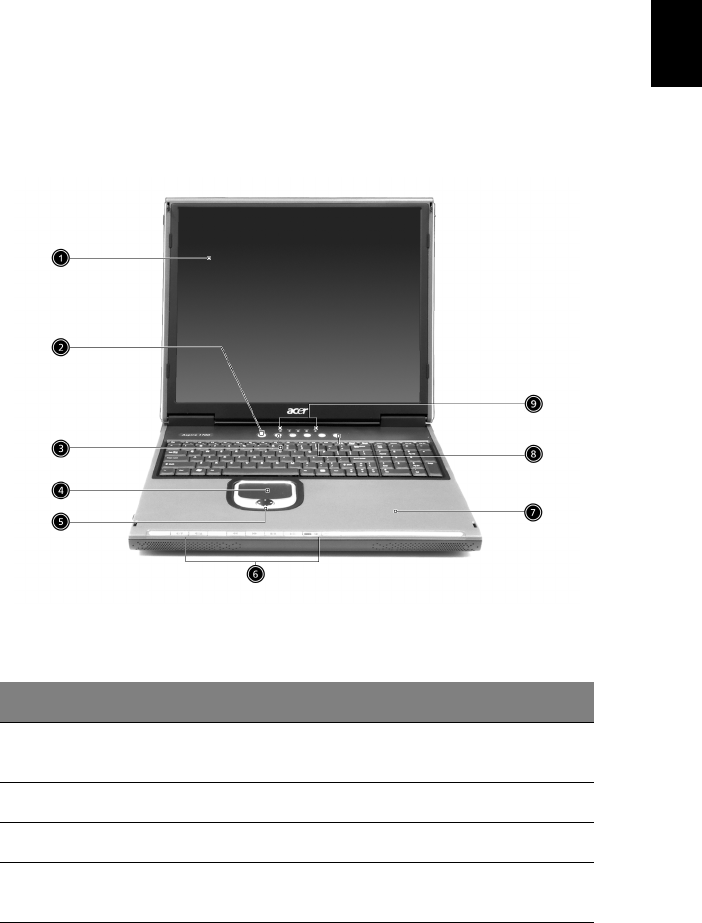
3
English
English
A tour of your computer
After setting up your new Aspire computer, as illustrated in the Just for
starters… poster, take a few minutes to explore the unit.
Opened front view
#Item Description
1 Display Large liquid crystal display (LCD) provides visual
output.
2 Power button Turns the computer on and off.
3 Keyboard Full-size keyboard for inputting typed data.
4 touchpad Touch sensitive pad that functions like a computer
mouse.
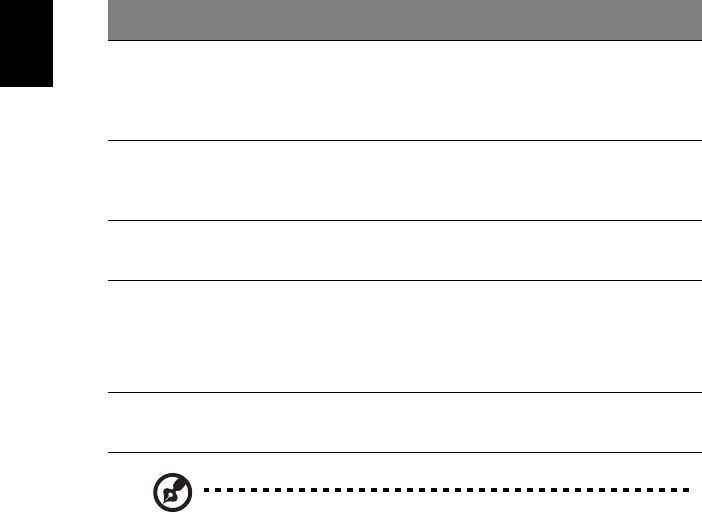
Getting familiar with your computer4
English
5 Click buttons &
scroll key
Right and left buttons that provide the same
functions as the buttons on a computer mouse.
The scroll key scrolls the contents of a window up
and down.
6 Audio DJ
controls and
indicator
Button and indicators for the Audio DJ function.
For more information, see “Audio” on page 27..
7 Palm rest Provides a comfortable platform for your hands
when typing on the keyboard.
8 Launch keys 1 switch button for wired LAN /wireless LAN
1 e-mail launch button
1 launch button for Internet browser
2 programmable buttons
9 Status
indicators
Light emitting diodes (LED) that show the status
of the computer and its components.
#Item Description
Note: This wireless communication button works for models
with 802.11g & 802.11a/g wireless LAN only.
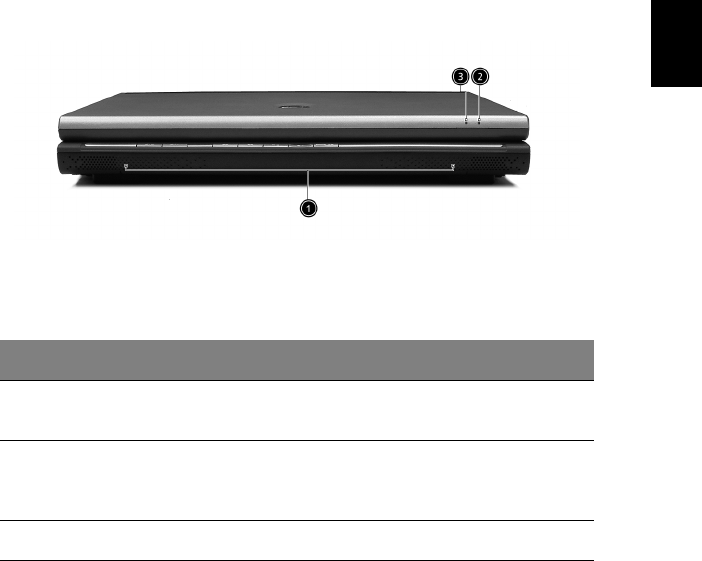
5
English
English
Closed Front view
#Item Description
1 Speakers Left and right speakers deliver stereo audio
output
2 Wireless
communication
indicator
Lights when the Wireless LAN capability is
enabled.
3 Power indicator Lights when the computer is on.
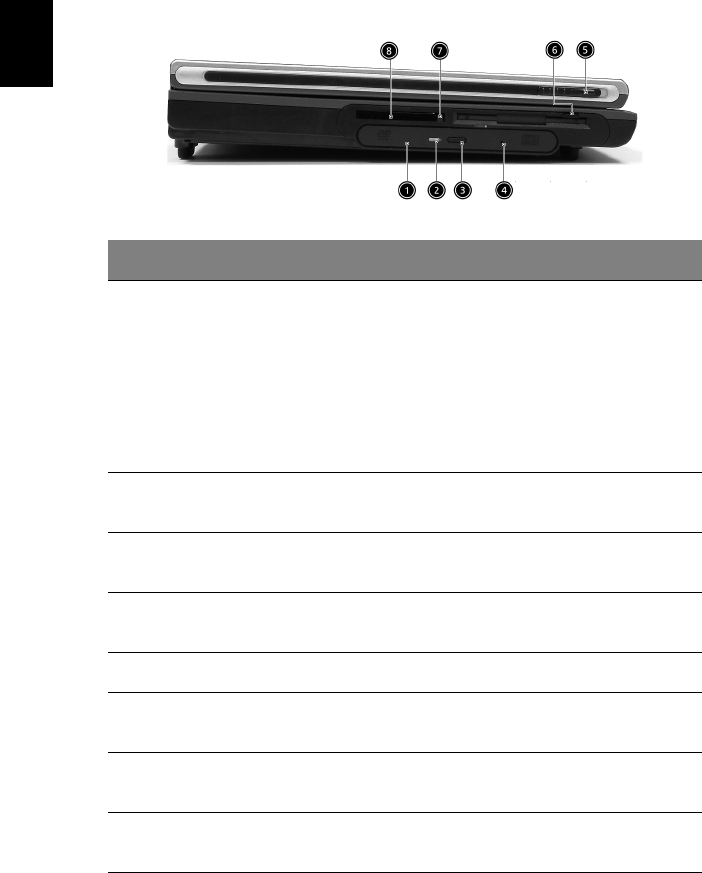
Getting familiar with your computer6
English
Left view
#Item Description
1Optical drive Depending on your model, the optical drive
is one of the following:
•CD-ROM drive for reading CDs.
•DVD-ROM drive for reading CDs and
DVDs.
•DVD/CD-RW combo drive for reading
CDs and DVDs, and writing to CD-Rs
and CD-RWs..
2 Optical disc read indicator Light emitting diode (LED) that indicates
when an optical disc is being read.
3 Optical drive eject button Press the eject button to remove a disc from
the optical drive.
4 Optical drive emergency
eject hole
Used to eject an optical disc when the
computer is turned off.
5 Floppy drive Accepts 3.5 inch floppy disk.
6 Left Latch Locks and releases the lid.(One on the right
and one on the left)
7 PC card eject button Press the eject button to remove a PC card
from the PC card slot.
8 PC card slot The slot supports a standard Type II PC card
(PCMCIA).
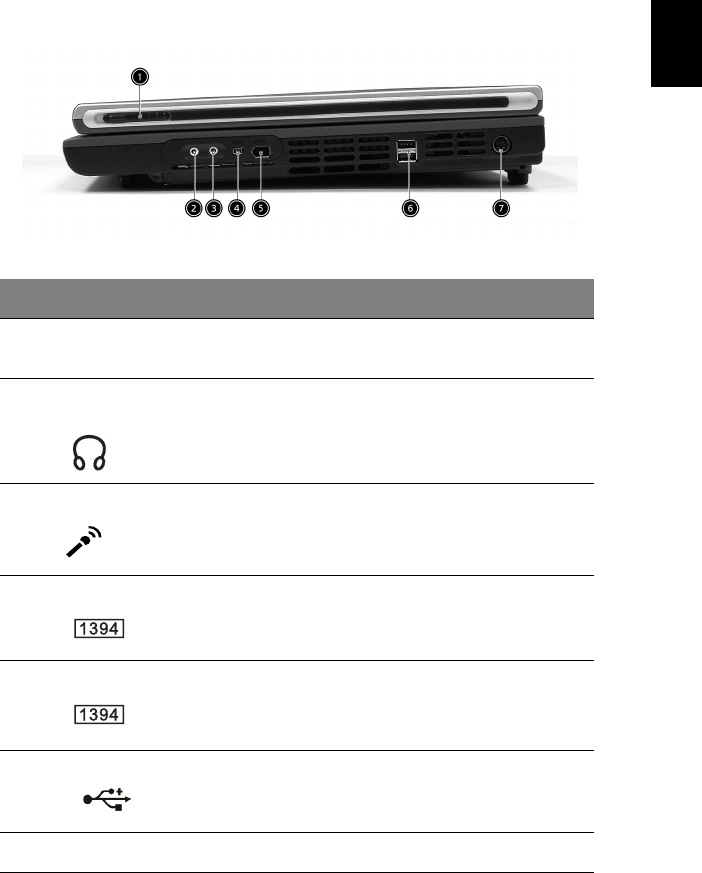
7
English
English
Right view
#Item Description
1 Right Latch Locks and releases the lid.(One on the right
and one on the left)
2 Speaker/Headphone-out
jack
Connects to audio line-out devices
(e.g.,speakers, headphones).
3 Line-in/Mic-in jack Accepts audio line-in devices (e.g., audio CD
player, stereo walkman). Selection is through
the OS Windows mixer.
4 IEEE 1394 port
Connects to an IEEE 1394 device.
5 IEEE 1394 port
Connects to an IEEE 1394 device.
6 USB ports
2 ports for connecting USB 2.0 devices.
7 DC-in jack Connects the AC adapter.
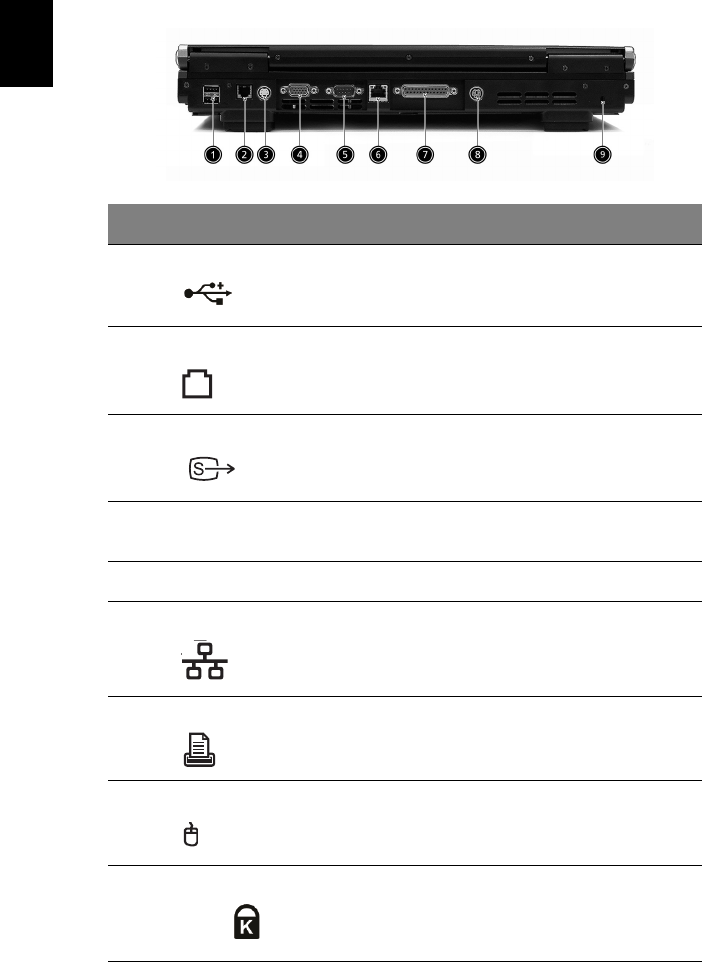
Getting familiar with your computer8
English
Rear view
#Item Description
1 USB ports 2 ports for connecting USB 2.0 devices.
2 Modem jack Connects the built-in fax/data modem to a phone
line.
3S-video
Connects to a television or display device with S-
video input.
4 External display port Connects an external (VGA) display devices
monitor.
5 COM port Connects to other serial interface devices.
6 Network jack Connects to an Ethernet 10/100/1000-based
network.
7 Parallel port Connects a parallel device, such as a printer.
8 PS2 port Connects to a PS2 mouse
9 Kensington lock slot For attaching a security connector.
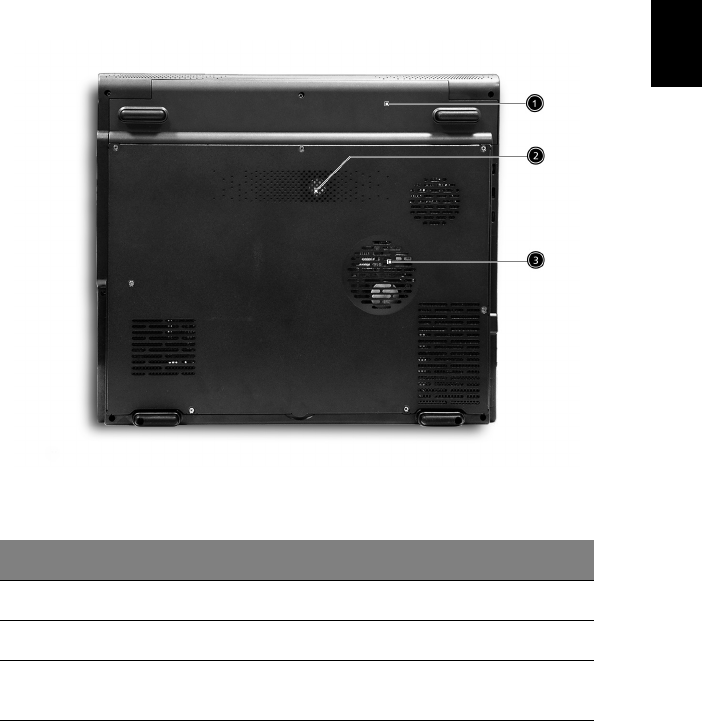
9
English
English
Bottom view
#Item Description
1 Battery cover Protects the battery bay.
2 Sub-woofer Enhance the audio quality.
3 Ventilation slots Enables the computer to stay cool, even after
prolonged use.

Getting familiar with your computer10
English
Features
Performance
•Intel® Pentium® 4 FSB 800 processor.
•L2 cache 1MB.
•Intel 865G with ICH-5, support 800MHz Front Side Bus , dual channel
and HTT support
•80 GB or higher-capacity Desktop 5400rpm, 7200rpm HDD.
•Microsoft® Windows® XP Home/Pro operating system.
•Optional 6-in-1 Multimedia memory card reader module
Multimedia
•CD-ROM.
•DVD-ROM.
•DVD/CD-RW combo.
•DVD Dual drive.
•Audio input and output jacks.
•Optional 6-in-1 Multimedia memory card reader module
•Hardware 3D graphic engine
•Two stereo speakers + One sub-woofer
•17" Desktop SXGA LCD, 1280x1024, 16M colors
Connectivity
•Modem: Software Modem V.92 56Kbps (MDC).
•10/100/1000 Mbps Gigabit Ethernet LAN .
•Optional Mini-PCI 802.11g or 802.11 a/g
•One switch to enable or disable wireless function
•Keyboard and Pointing Device
•4 universal serial bus (USB) ports 2.0.

11
English
English
Human-centric design and ergonomics
•All-in-one design (incorporating hard drive, optical drive and floppy disk
drive).
•Rugged and space saving.
•Full-size Desktop keyboard.
•No need to turn on the system for playing CD or MP3
•Large & comfortable palm rest area with well-positioned touchpad.
Expansion
•PC card slot enables a range of add-on options.
•Upgradeable CPU, hard disk and memory modules.

Getting familiar with your computer12
English
Display
The 17” display panel provides a large viewing area for maximum efficiency
and ease-of-use. The liquid crystal display (LCD) supports SXGA resolution
with16 million colors at 1280 x 1024 .
Video performance
Your Aspire 1710 series computer features an accelerated graphics port (AGP)
video system with Intel 865G 8X, and nVIDIA NV-18M/NV-34M/NV-31M w/
64MB or 128MB and NV-36M 8x AGP card as option. This provides a robust
solution, while enabling high quality video output.
Simultaneous display
Your computer's large display, combined with its multimedia capabilities,
makes it ideally suited to delivering presentations.
You can also connect an external monitor or projector, and then choose to
use the computer's LCD panel only, the external device only, or the LCD panel
and external device simultaneously.
Simultaneous display allows you to manage a presentation on your computer,
while your audience watches the monitor or projector screen.
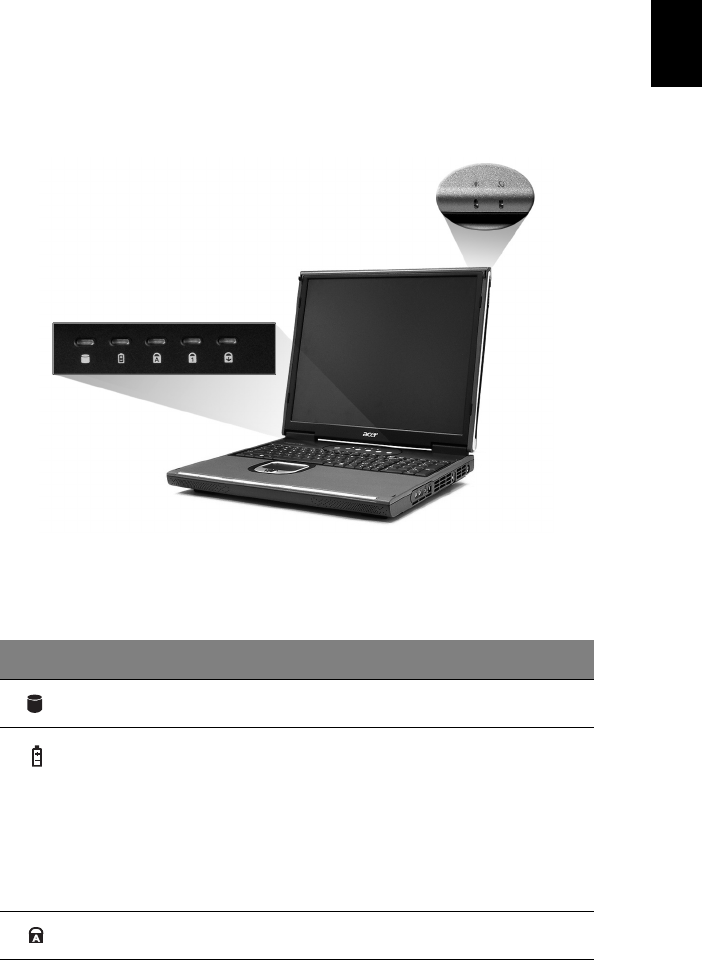
13
English
English
Indicators
Your computer provides an array of five indicators located above the
keyboard, in addition to two indicators positioned at the top right hand
corner of the LCD panel. These indicators show the status of the computer
and its components.
The five indicators located above the keyboard provide the following status
information:
#Description
1 Hard disk drive activity.
2 Battery charge:
Green the AC adapter is connected and the battery is fully
charged.
Amber the AC adapter is connected and the battery is
charging.
Off the AC adapter is not connected, or the battery is
not installed.
3 Caps Lock active.
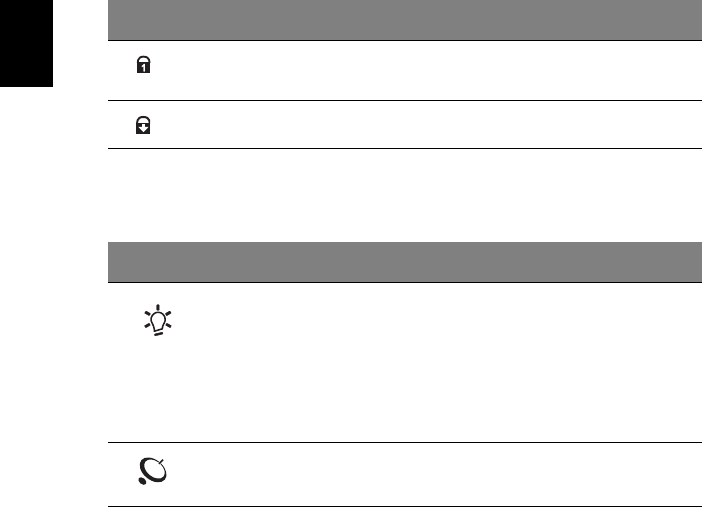
Getting familiar with your computer14
English
The two indicators located at the front of the unit provide the following status
information:
4 Num Lock active. (Note: the keypad lock must be turned on to use
the embedded numeric keypad.)
5 Scroll Lock active.
#Description
1 Power mode:
Steady green the computer is on (even if the display is
turned off).
Steady orange the computer is in standby mode.
Off the computer is turned off, or in hibernation
mode.
2 InviLink indicator:
Indicates status of (optional) wireless communication.
#Description
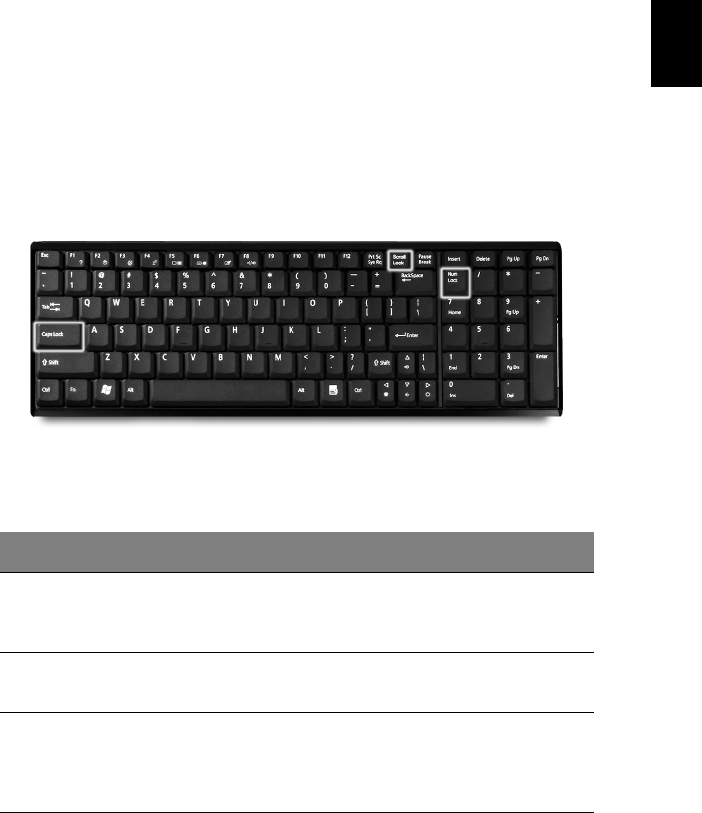
15
English
English
Keyboard
The keyboard features full-size keys with an embedded keypad, separate
cursor control keys, two Windows keys, and twelve function keys (hot keys).
Special keys
Lock keys
The computer features three lock keys, each with its own status indicator
light.
Lock Key Description
Caps Lock When Caps Lock is on, all alphabetic characters are typed in
uppercase. Toggle on and off by pressing the Caps Lock key on the
left side of the keyboard.
Num Lock When Num Lock is on, the embedded numeric keypad can be used.
Toggle on and off by pressing the Num Lock Key.
Scroll Lock When Scroll Lock is on, the screen toggles up or down one line at a
time when the up and down cursor control keys are pressed. Note:
Scroll Lock doesn't work in all applications. Toggle on and off by
pressing the Scroll Lock Key.
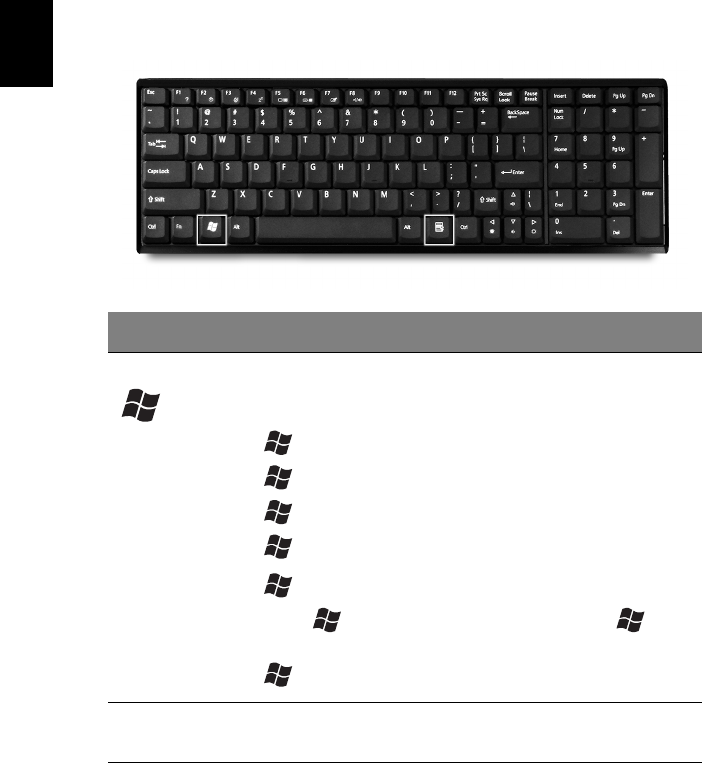
Getting familiar with your computer16
English
Windows keys
The keyboard features two keys that provide Windows-specific functions.
Key Description
Windows key Pressed alone, this key has the same effect as clicking on the
Windows Start button; it launches the Start menu. It can also
be used with other keys to provide a variety of functions:
+ Tab activates the next Task bar button.
+ E opens the My Computer window.
+ F1 opens Help and Support.
+ F opens the Find: All Files dialog box.
+ M minimizes all windows.
Shift + + M undoes the minimize all windows ( + M)
action.
+ R opens the Run dialog box.
Application key This key has the same effect as clicking the right mouse
button; it opens the application's context menu.
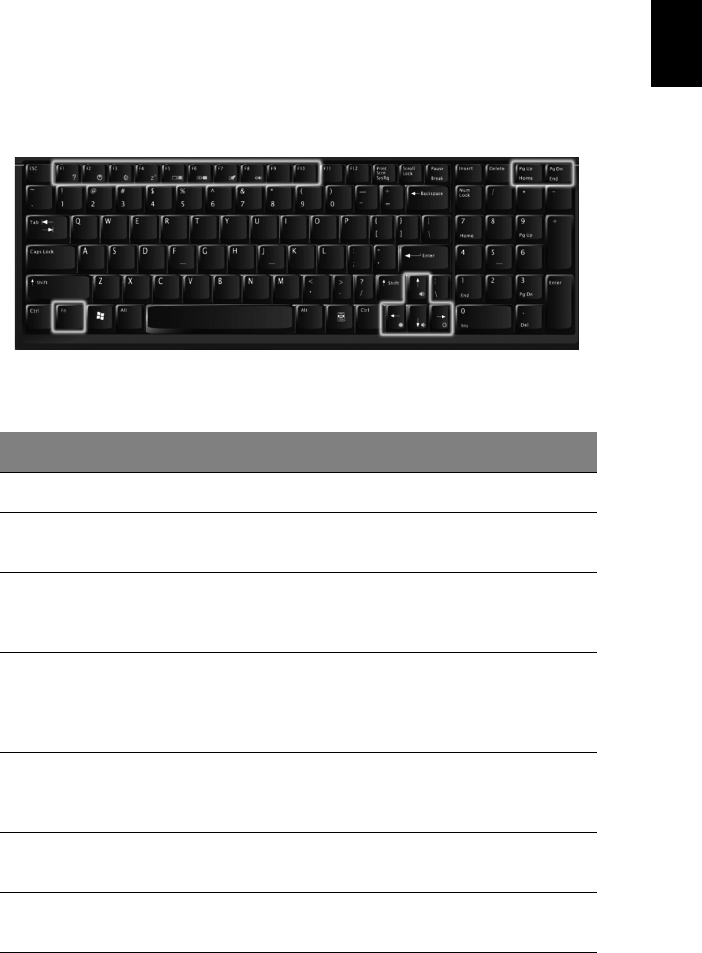
17
English
English
Hotkeys
Using the Fn key with another key creates a hot key, providing a quick and
convenient method for controlling various functions.
To use a hot key, first hold down the Fn key. Next, press the second key in the
combination. Finally, release both keys.
Your computer provides the following hot keys:
HotKey Function
Fn + F1 Hot key help Display this help file
Fn + F2 Device
Manager
Accesses Windows Device Manager
Fn + F3 Power
scheme
toggle
Selects suitable power scheme to the system
Fn + F4 Sleep Puts the computer in Sleep Mode, which can be
defined via the advanced section of the Power
Management Properties in the Windows Control
Panel
Fn + F5 Display
toggle
Switches display output between the system LCD,
an external monitor and both the system LCD and
external monitor.
Fn + F6 Screen blank Turn the LCD backlight off to save power; press
any key to resume
Fn + F7 touchpad on/
off
Turns the internal touchpad on and off
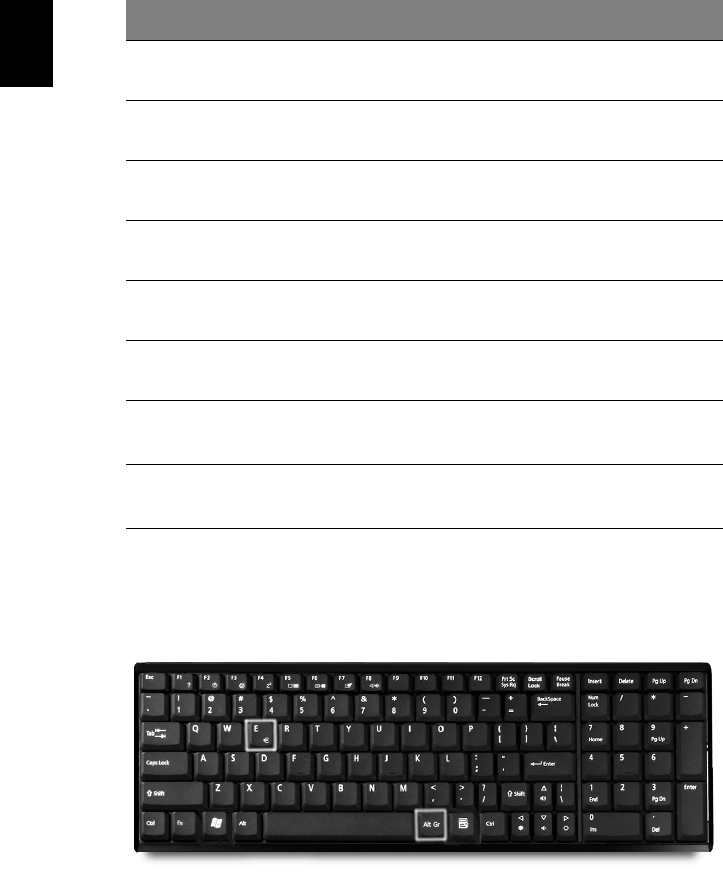
Getting familiar with your computer18
English
Euro key
Your computer supports the new Euro currency character. First, hold down
the Alt Gr key, and then press the Euro key..
Fn + F8 Speaker
on/off
Turns the speakers on and off
Fn + F9 Audio DJ
on/off
Turns the Audio DJ function on and off within
Windows.
Fn + <right
arrow>
Brightness
up
Increases the screen brightness
Fn + <Left
arrow>
Brightness
down
Decrease the screen brightness
Fn + <up
arrow>
Volume up Increase the volume
Fn + <down
arrow>
Volume
down
Decrease the volume
Fn + Pg Up
Home
Home Moves the cursor to the beginning of a sentence.
Fn + Pg Dn
End
End Moves the cursor to the end of a sentence.
HotKey Function

19
English
English
Keyboard ergonomics
The wide palm rest area provides a comfortable platform for your hands
when typing on the keyboard. The ergonomic design enables you to adopt a
relaxed, yet very efficient, typing style.
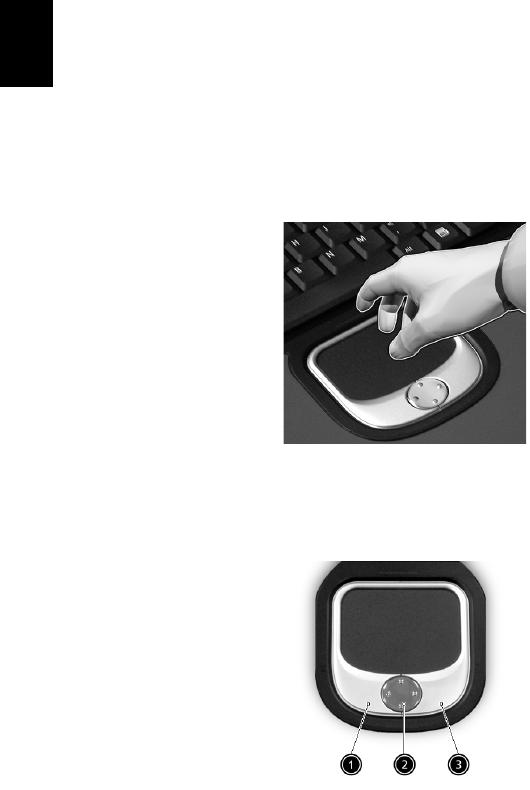
Getting familiar with your computer20
English
Touchpad
The built-in touchpad is a PS/2- compatible pointing device that senses
movement on its surface. The cursor responds to your finger movements on
the touchpad. In addition, the two click buttons provide the same
functionality as a computer mouse, while the scroll key enables easy up and
down scrolling in documents and web pages.
The touchpad is located in the middle of the palm rest area, providing
maximum comfort and efficiency.
Tou ch pa d b as ic s
Use the touchpad as follows:
•Slide your finger over the surface of the touchpad to control the
movement of the cursor. Tap the touchpad to perform selection and
execution functions.
•Press the left (1) and right (3) click buttons to perform selection and
execution functions, just as you would use the buttons on a computer
mouse.
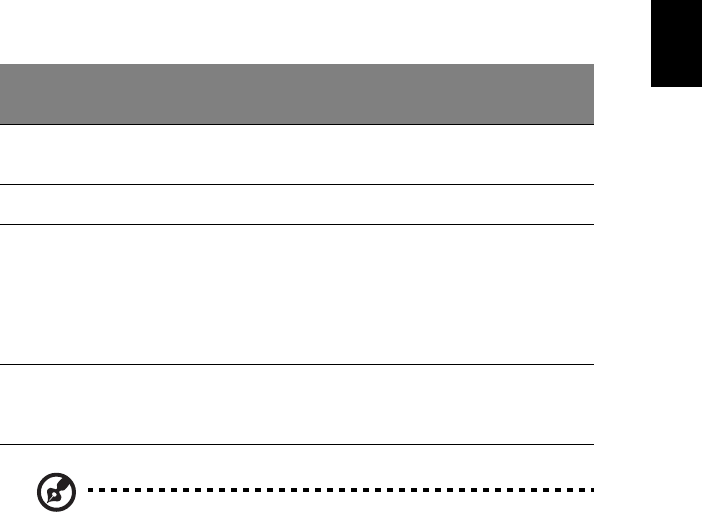
21
English
English
•Use the scroll key (2) to scroll through long documents and web pages.
Press the top of the key to scroll up, and the bottom to scroll down.
Note: keep your fingers, as well as the surface of the touchpad, clean
and dry. The touchpad is sensitive to your finger movements: the lighter
your touch, the better the response. Tapping hard will not increase the
touchpad's responsiveness.
Function Left Button Right
Button Ta p
Execute Click twice
quickly.
Tap twice quickly.
Select Click once. Tap once.
Drag Click and hold.
Then, slide your
finger across the
touchpad to drag
the cursor over
the selection.
Tap twice quickly. On the second
tap, slide your finger across the
touchpad to drag the cursor over
the selection.
Access
content
menu
Click
once.
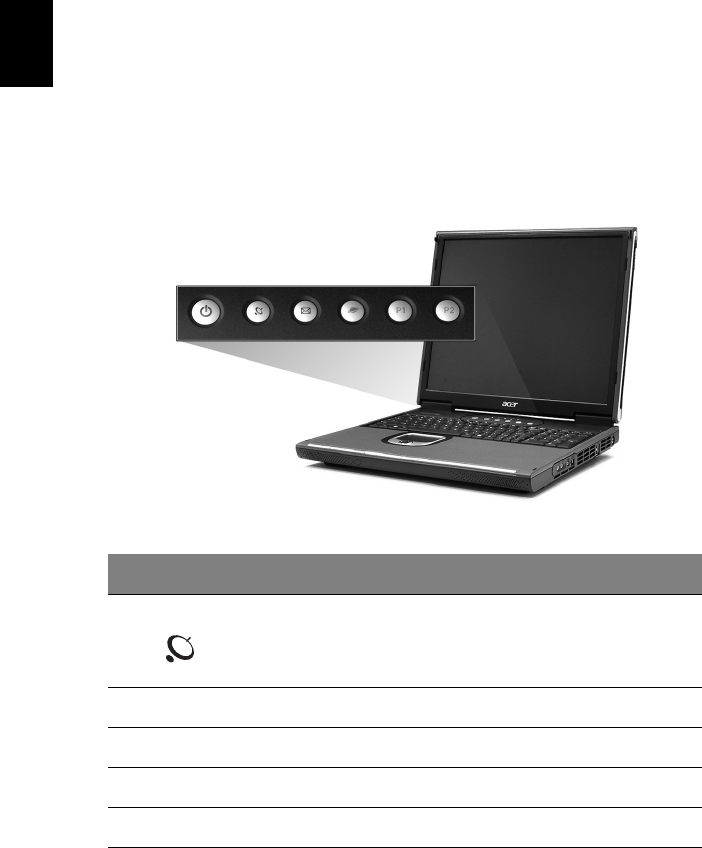
Getting familiar with your computer22
English
Launch keys
Located at the top of the keyboard are five buttons. These buttons are called
launch keys. They are designated as key 1,key 2,key 3,key 4 and key 5. By
default, key 1 is used to launch wireless LAN, key 2 is used to launch the
E-mail application and key 3 is used to launch the Internet browser. Keys 3
and 4 start the Launch Manager application. All five launch keys can be set
by the user. To set the launch keys, run the Acer Launch Manager.
Launch key Default application
InviLink button Enable or disable wireless connectivity.
E-mail Launches your E-mail application.
Web browser Launches your Internet browser.
P1 User-programmable
P2 User-programmable
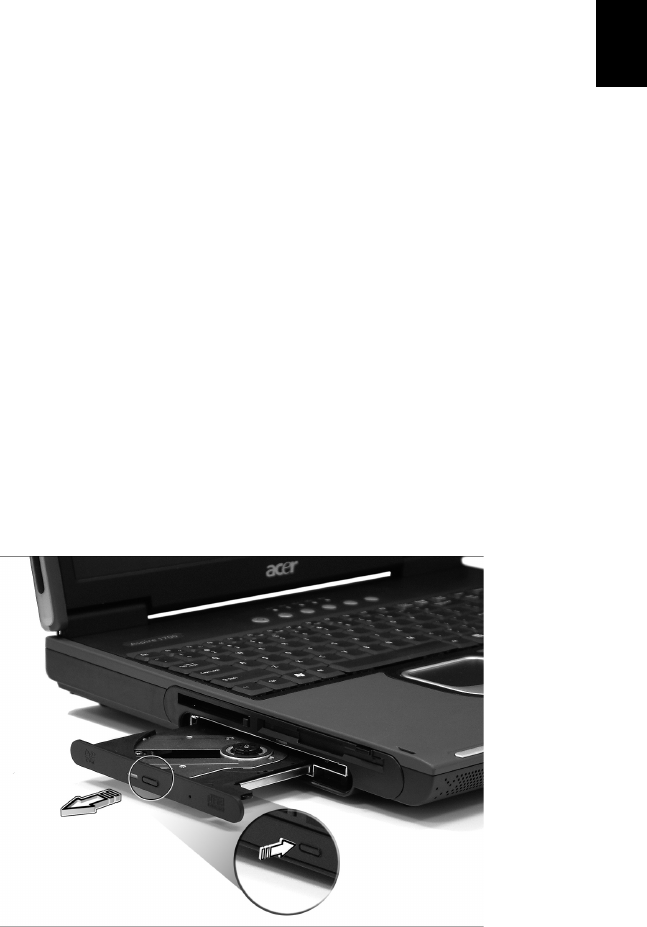
23
English
English
Storage
Your computer's all-in-one design offers a variety of data storage options:
•The high capacity Enhanced-IDE hard disk drive.
The hard drive is upgradeable, enabling you to increase your storage
capacity in the future. Consult your dealer if you need to upgrade.
•The high speed optical drive.
Depending on your model, you have a CD-ROM, DVD-ROM, DVD/CD-
RW combo drive, or DVD dual drive. The optical drive provides increased
storage capacity, as well as offering a host of multimedia possibilities.
See the section entitled, "A tour of your computer," for the locations of these
drives.
Ejecting the optical drive tray
To eject the optical drive tray:
•With the computer turned on, press the optical drive eject button.
•The tray will be released, and partially pop open.
•Gently pull the tray out to its limit.
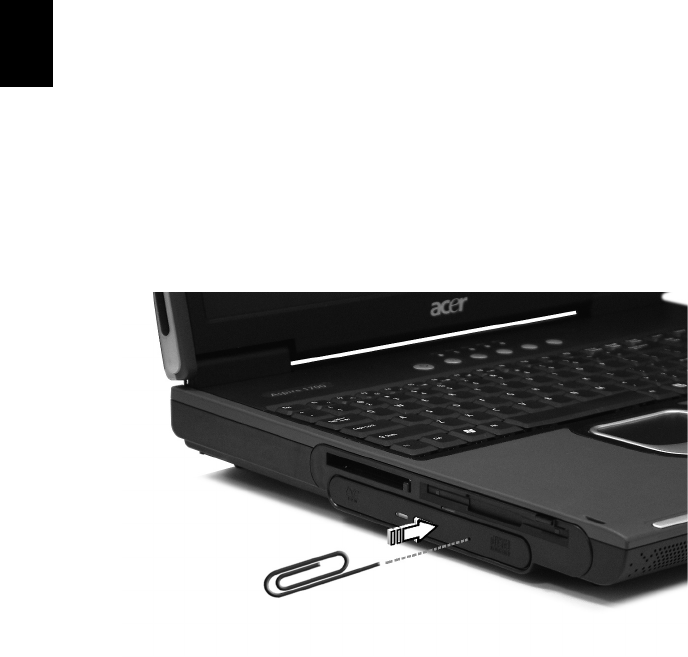
Getting familiar with your computer24
English
To load an optical disc:
•Place a CD or DVD on the open tray. Align the disc's center hole with the
tray's spindle.
•Gently push down on the disc until it clicks in place on the spindle.
•Gently push in the tray until it clicks closed.
Emergency ejection of the optical drive tray
If you need to eject the optical drive tray when the computer is turned off,
push a straightened paper clip into the optical drive emergency eject hole.
The tray will be released, and partially pop open.
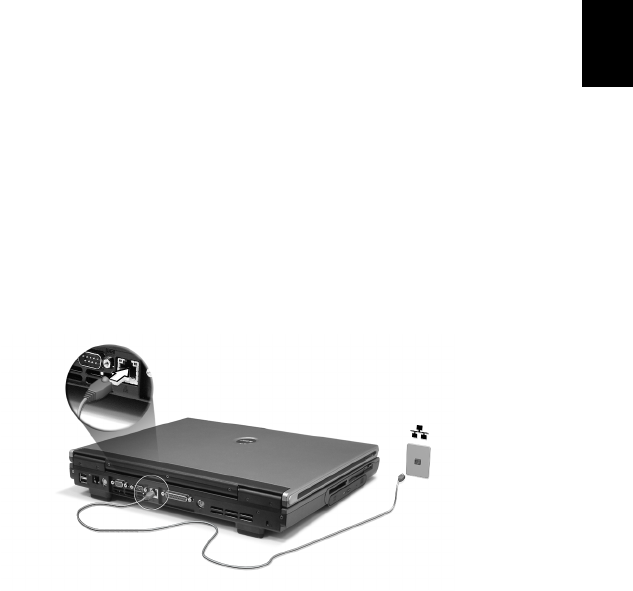
25
English
English
Connectivity options
Your computer has built-in connectivity options, enabling you to hook up to a
network or communicate over a phone line.
Ethernet and LAN
The integrated network feature allows you to connect your computer to an
Ethernet-based (10/100/1000Mbps) network.
To use the network feature, plug an Ethernet cable into your computer's
network jack, and then connect the other end to a network jack or hub on
your network.
See Windows Help for information on setting up a network connection.
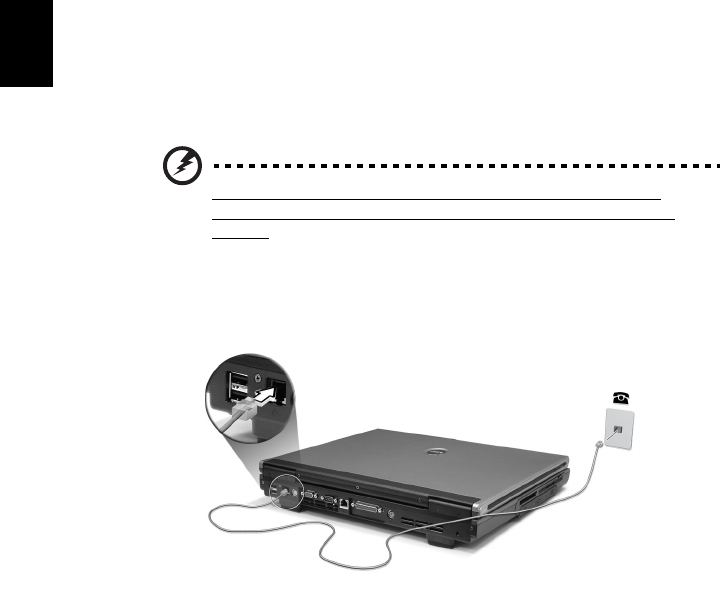
Getting familiar with your computer26
English
Fax/data modem
Your computer features a software modem(V.92 56Kbps), enabling you to
communicate over a phone line. This means that you can connect to the
Internet via a dialup account with an ISP, log in to your network from a
remote location, or send faxes.
Warning: your modem is not compatible with digital phone lines.
Plugging the computer into a digital phone system will damage the
modem.
To use the fax/data modem, plug a phone cable into your computer's modem
jack, and then connect the other end to a telephone jack.
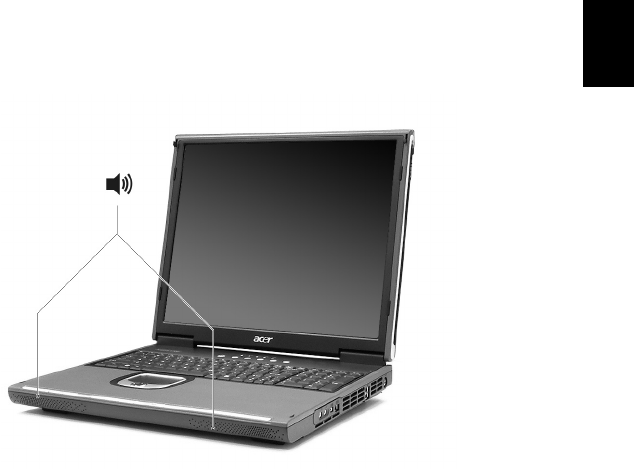
27
English
English
Audio
Your computer includes an integrated stereo audio system. Built-in stereo
speakers and a sub woofer are located at the front of the unit.
Volume is adjusted using software, such as Volume Control in Windows, or
any other application that provides a volume adjustment control.
Two audio ports on the right side of the computer enable external devices to
be connected. See “A tour of your computer” on page 3 for the location of
the audio ports. For information on connecting external devices, See “Audio
devices” on page 45.

Getting familiar with your computer28
English
Audio DJ
Audio DJ offers all the convenience of an audio CD / MP3 player, enabling
you to play your favorite music CDs or “My MP3” folder from the HDD even
when your computer is in power-off mode.
Operate Audio DJ as follows:
• Press “Play” button to turn on the audio function.
• Press both “Volume Up” & “Volume Down” buttons at the same time to
select the “My MP3” folder from HDD.
• Press the Stop/Eject button, and then load a CD into the CD/DVD drive.
Push the drawer to close it.
• Press the Play/Pause button to start playing the CD or the selected MP3.
• Use the other buttons to control the playback of the CD or MP3.
• Audio DJ can be shut down by:
• pressing the system power button, or
• pressing the Stop/Eject button to end playback, when inactive for 5
minutes, the system will power down automatically
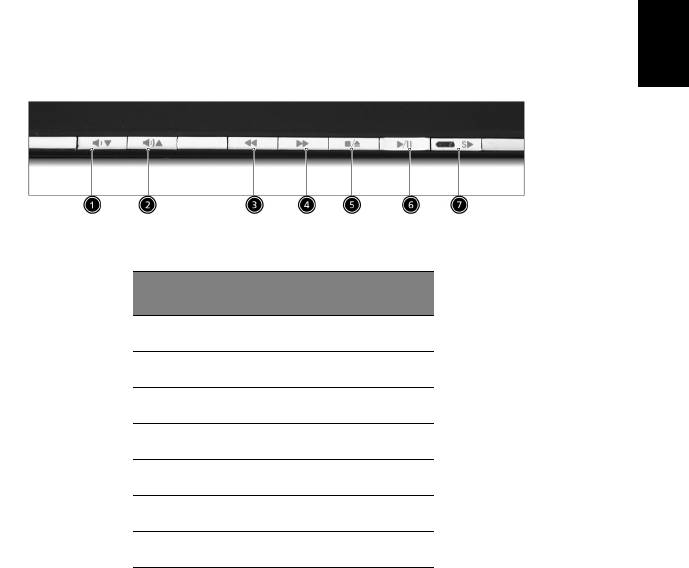
29
English
English
Audio DJ features the following control buttons
No. Description
1 Volume Down
2 Volume Up
3 Previous Track
4 Next Track
5 Stop/Eject
6Play/Pause
7 Shuffle On/Shuffle Off
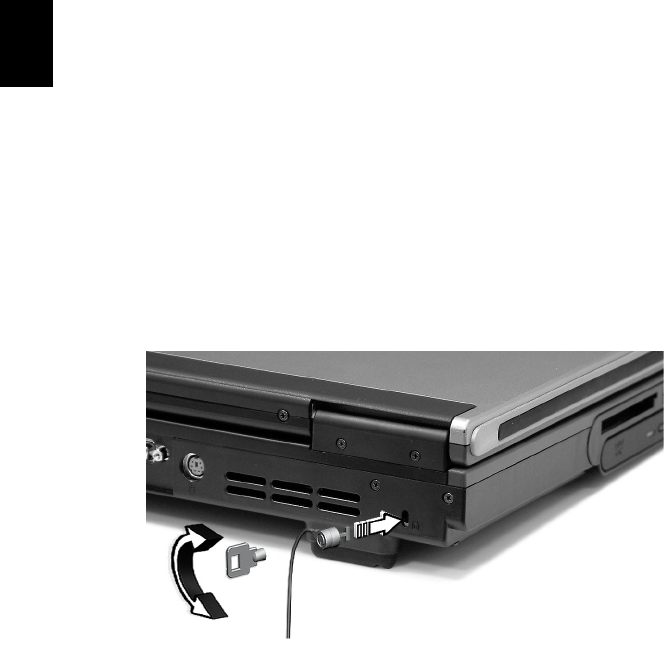
Getting familiar with your computer30
English
Securing your computer
Your computer features hardware and software security solutions, in the form
of a slot for a Kensington lock and a password facility.
Security slot
A slot for a Kensington slot enables you to physically protect your computer
from theft. Use this feature as follows:
•Wrap a security lock cable around a heavy or immoveable object, such as
a drawer handle on a file cabinet, or a table leg.
•Insert the lock into the slot on the computer, turn it 90°, and then lock it
in place.

31
English
English
Passwords
You can protect your computer from unauthorized access by setting
Windows password protection. The user must enter the password before
beginning a Windows session.
•First, open User Accounts in Windows Control Panel and select your
account.
•Click Create a Password, and then set your desired password.
•Click Performance and Maintenance, Power Options in Control Panel.
•On the Advanced tab, select the option to prompt for a password when
your computer resumes from stand by.
To cancel password protection, reset the password with a blank password.

Getting familiar with your computer32
English

Operating on battery
power

Your Aspire 1710 series computer operates on
battery or AC power.
This chapter provides information for operating on
battery power, as well as information on how your
computer manages and saves power.

35
English
English
Battery pack (Optional)
Your computer uses a re-chargeable 12-cell Li-ion 2.2Ah battery pack.
Battery pack characteristics
The battery pack has the following characteristics:
•Employs current battery technology standards.
•Delivers a battery-low warning.
A Li-ion battery can be recharged at any time.
The battery is recharged whenever you connect the computer to the
mains power supply. Your computer supports charge-in-use, enabling
you to recharge the battery while you continue to operate the
computer. However, recharging with the computer turned off results in
a significantly faster charge time.
The battery will come in handy when you travel or during a power
failure. It is advisable to have an extra fully charged battery pack
available as backup. Contact your dealer for details on ordering a spare
battery pack.
Maximizing the battery's life
Like all other batteries, your computer's battery will degrade over
time. This means that the battery's performance will diminish with
time and use. To maximize your battery's life, you are advised to
adhere to the recommendations set out below.
Conditioning a new battery pack
Before you use a battery pack for the first time, there is a
"conditioning" process that you should follow:
1Insert the new battery in the computer. Do not turn the computer
on.
2Connect the AC adapter and fully charge the battery.
3Disconnect the AC adapter.
4Turn on the computer and operate using battery power.
5Fully deplete the battery until the battery-low warning appears.
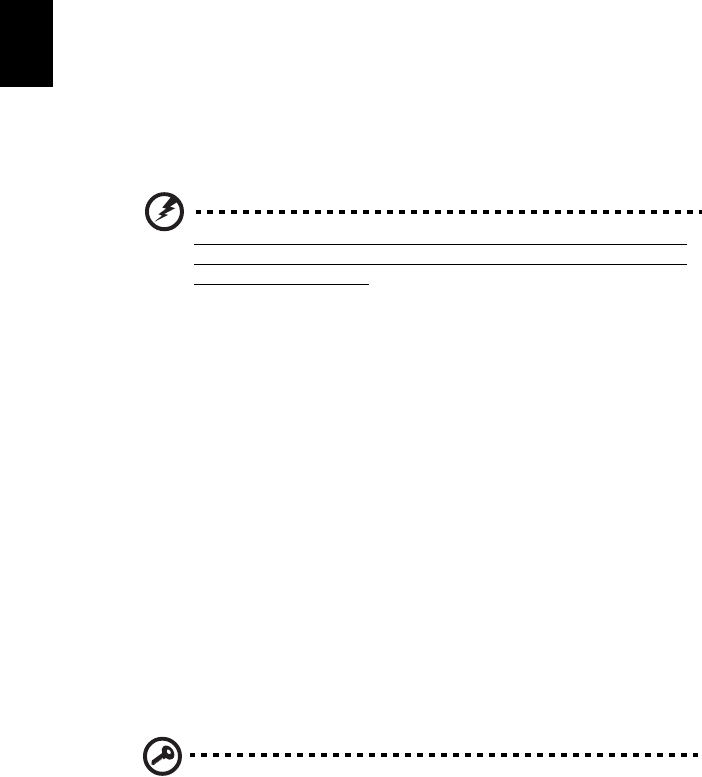
Operating on battery power36
English
6Reconnect the AC adapter and fully charge the battery again.
Follow these steps again until the battery has been charged and
discharged three times.
Use this conditioning process for all new batteries, or if a battery hasn't
been used for a long time. If the computer is to be stored for more
than two weeks, you are advised to remove the battery pack from the
unit.
Warning: do not expose battery packs to temperatures below 0°C
(32°F) or above 60°C (140°F). Extreme temperatures may adversely
affect the battery pack.
By following the battery conditioning process you condition your
battery to accept the maximum possible charge. Failure to follow this
procedure will prevent you from obtaining the maximum battery
charge, and will also shorten the effective life span of the battery.
In addition, the useful life span of the battery is adversely affected by
the following usage patterns:
•Using the computer on constant AC power with the battery
inserted. If you want to use constant AC power, you are advised to
remove the battery pack after it is fully charged.
•Not discharging and recharging the battery to its extremes, as
described above.
•Frequent use; the more you use the battery, the faster it will reach
the end of its effective life. A standard computer battery has a life
span of about 500 charges.
Installing and removing the battery pack
Important! Before removing the battery from the unit, connect
the AC adapter if you want to continue using your computer.
Otherwise, turn off the computer first.
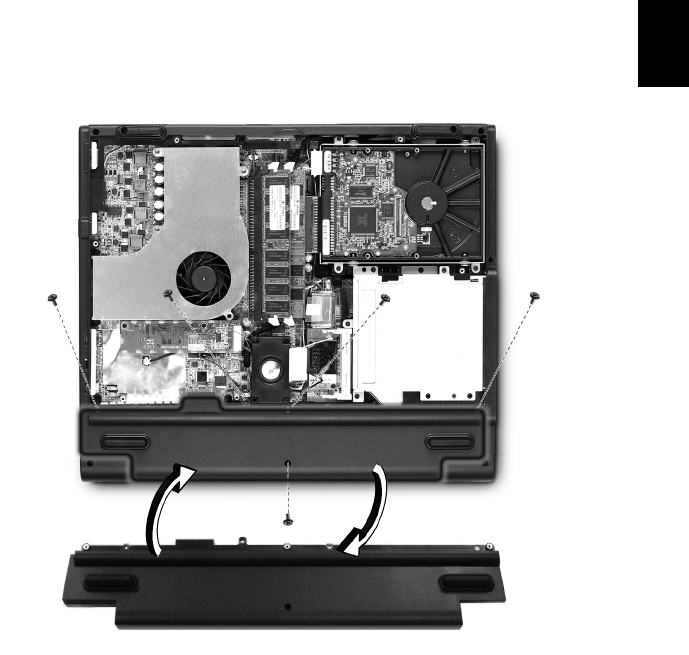
37
English
English
To install a battery pack:
* Please refer to “Opening The Case” on page 49 before you proceed
to next step.
1Loosen the screws on the battery cover and remove it from the
battery bay.
2Align the battery to the battery bay and tighten the screws.
To remove a battery pack:
1Refer to “Opening The Case” on page 49.
2Loosen the battery screws.
3Pull the battery from the battery bay.

Operating on battery power38
English
Charging the battery
To charge the battery, first make sure that it is correctly installed in the
battery bay. Plug the AC adapter into the computer, and connect to a
mains power outlet. You can continue to operate your computer on AC
power while your battery is charging. However, charging the battery
with the computer turned off results in a significantly faster charge
time.
Note: you are advised to charge the battery before retiring for the
day. Allowing the battery to charge overnight before traveling
enables you to start the next day with a fully charged battery.
Checking the battery level
The Windows Power Meter indicates the current battery level. Rest the
cursor over the battery/power icon on the task bar to see the battery's
present charge level.
Optimizing battery life
Optimizing battery life helps you get the most out of battery
operation, prolonging the charge/recharge cycle and improving
recharging efficiency. You are advised to follow the suggestions set out
below:
•Purchase an extra battery pack.
•Use AC power whenever possible, reserving your battery for on-
the-go use.
•Eject a PC card if it is not being used, as it will continue to draw
power.
•Store the battery pack in a cool, dry place. The recommended
temperature is 10°C to 30°C. Higher temperatures cause the
battery to self-discharge faster.
•Excessive recharging decreases the battery life.
•Look after your AC adapter and battery. See, "Taking care of your
AC adapter".
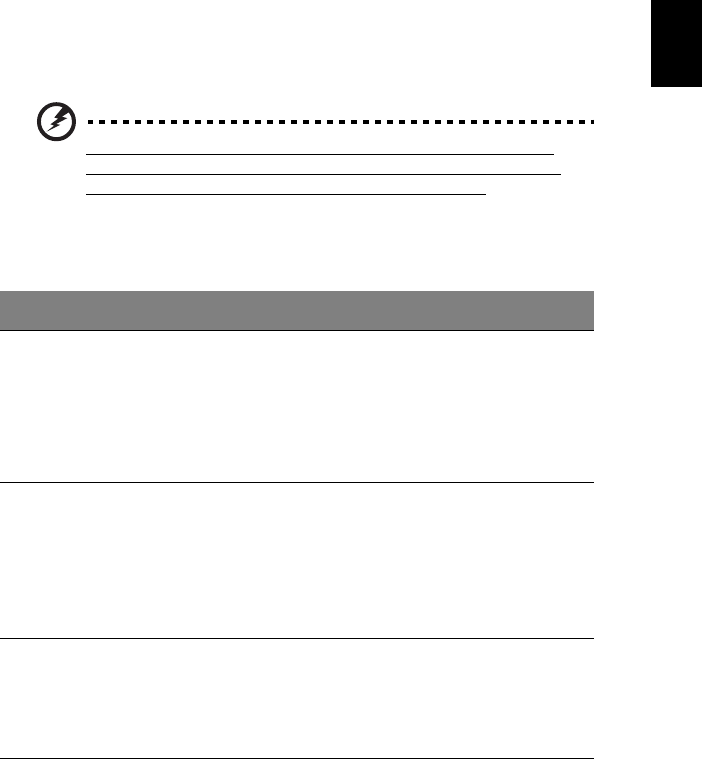
39
English
English
Battery-low warning
When using battery power pay attention to the Windows Power
Meter.
Warning: connect the AC adapter as soon as possible after the
battery-low warning appears. Data will be lost if the battery to
become fully depleted and the computer shuts down.
When the battery-low warning appears, the recommended course of
action depends on your situation:
Situation Recommended Action
The AC adapter
and a power
outlet are
available.
1. Plug the AC adapter into the computer, and then
connect to the mains power supply.
2. Save all necessary files.
3. Resume work.
Turn off the computer if you want to recharge the
battery rapidly.
An extra fully
charged battery
pack is available.
1. Save all necessary files.
2. Close all applications.
3. Shut down the operating system to turn off the
computer.
4. Replace the battery pack.
5. Turn on the computer and resume work.
The AC adapter or
a power outlet is
unavailable. You
have no spare
battery pack.
1. Save all necessary files.
2. Close all applications.
3. Shut down the operating system to turn off the
computer.

Operating on battery power40
English
Power management
Your computer features a built-in power management unit that
constantly monitors system activity. System activity refers to any
activity involving one or more of the following devices: keyboard,
touchpad/mouse, floppy disk drive, hard disk drive, optical drive,
peripherals connected to the computer. If no activity is detected for a
period of time (the settings are controlled in Windows Power
Management), the computer turns off some, or all, of these devices in
order to conserve power.
Your computer employs a power management scheme that supports
ACPI (Advanced Configuration and Power Interface), enabling
maximum power conservation without compromising system
performance. ACPI allows Windows to control the amount of power
given to each device attached to the computer. In this way, Windows
handles all power-saving chores for your computer. Refer to Windows
Help for more information.